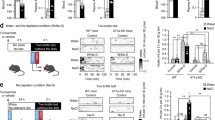Summary
-
1.
Toads maintained in fresh water and submitted periodically to careful manipulation showed higher urine production than water uptake, and body weight loss.
-
2.
After complete removal of the ADH (antidiuretic hormone) secreting system, animals developed polyuria without changes in water uptake, and extreme body weight loss.
-
3.
Small lesions of the midbrain midtegmental area caused a stable and copious intake of water across the skin, polyuria, negative water balance and body weight loss. A similar but temporary increase in water uptake, combined with oliguria, and a gain of body weight was observed during the reversible coma induced by blocking the same region of the midbrain with a microinjection of 3 M KCl, in both normal and hypophysectomized toads.
-
4.
General anesthesia with urethan reproduced closely the picture of polyuria and high water intake due to midbrain lesion in normal as well as in hypophysectomized animals.
-
5.
We postulate an extrahypophyseal nervous mechanism that controls the influx of water across the skin and urine production in the toad, with its focus in the midbrain midtegmental area.
Similar content being viewed by others
Abbreviations
- BW :
-
body weight
- SW :
-
standard weight
- S :
-
sham operated
- HR :
-
totally hypophysectomized, postchiasmatic sectioned, infundibulum lesioned
- T :
-
midbrain midtegmental lesions
- HRT :
-
totally hypophysectomized, postchiasmatic sectioned infundibulum and midbrain midtegmental lesion
- FB :
-
forebrain lesioned
- P :
-
spinal cord destroyed
- Cc :
-
closed cloaca
- Uc :
-
ureter cannulated
- AOV :
-
analysis of variance
References
Adolph EF (1934) Influence of the nervous system on the intake and excretion of water by the frog. J Cell Comp Physiol 5:123–139
Ambalavanar S, Foster RW, Schnieden H (1972) Effects of sympathomimetics on water movement across toad isolated bladder. J Pharm Pharmacol 24:501–502
Bakker HR, Bradshaw SD (1977) Effect of hypothalamic lesions on water metabolism of the toadBufo marinus. J Endocrinol 75:161–172
Bentley PJ (1958) The effects of neurohypophysial extracts on water transfer across the wall of the isolated urinary bladder of the toadBufo marinus. J Endocrinol 17:201–209
Bentley PJ (1971) Endocrines and osmoregulation. Springer, Berlin Heidelberg New York, pp 201–209
Bentley PJ (1972) Inhibition by dopamine of the hydro-osmotic response (water transfer) of the toad bladder to vasopressin. J Pharmacol Exp Ther 181:155–160
Claussen DL (1974) Urinary bladder water reserves in the terrestrial toad,Bufo fowleri and the aquatic frog,Rana clamitans. Herpetologica 30:360–365
Ewer RF (1952) The effect of pituitrin on fluid distribution inBufo regularis Reuss. J Exp Biol 29:173–177
Ginsburg M, Brown LM (1957) The effects of haemorrhage and plasma hypertonicity on the neurohypophysis. In: Heller H (ed) The neurohypophysis, Butterworths, London, p 109
Koefoed-Johnsen V, Ussing HH (1953) The contribution of diffusion and flow to the passage of D2O through living membranes. Acta Physiol Scand 28:60–76
Leaf A (1965) Transepithelial transport and its hormonal control in toad bladder. Ergeb Physiol Biol Chem Exp Pharmakol 56:216–263
Parent A (1973) Distribution of monoamine containing neurons in the brain stem of the frog,Rana temporaria. J Morphol 139:67–71
Porter KP (1972) Herpetology: Saunders, Philadelphia
Ripoche P, Bourguet J, Parisi M (1973) The effect of hypertonic media on water permeability of frog urinary bladder. Inhibition by catecholamines and prostaglandin E1: J Gen Physiol 61:110–124
Ruibal R (1962) The adaptive value of bladder water in the toad,Bufo cognatus. Physiol Zool 35:218–223
Sawyer WH (1951) Effects of posterior pituitary extracts on urine formation and glomerular circulation in the frog. Am J Physiol 164:457–466
Sawyer WH (1957) Increased renal reabsortion of osmotically free water by the toad,Bufo marinus, in response to neurohypophysial hormones. Am J Physiol 189:564–568
Shoemaker VH, Waring H (1968) Effect of hypothalamic lesions on the water-balance response of a toad (Bufo marinus). Comp Biochem Physiol 24:47–54
Shoemaker VH, Nagy KA (1977) Osmoregulation in amphibians and reptiles. Ann Rev Physiol 39:449–471
Author information
Authors and Affiliations
Additional information
This work was supported by a grant from the Consejo Nacional de Investigaciones Cientificas y Técnicas
Rights and permissions
About this article
Cite this article
Segura, E.T., Bandsholm, U.C., Bronstein, A. et al. Role of the CNS in the control of the water economy of the toadBufo arenarum Hensel. J Comp Physiol B 146, 95–100 (1982). https://doi.org/10.1007/BF00688721
Accepted:
Issue Date:
DOI: https://doi.org/10.1007/BF00688721




